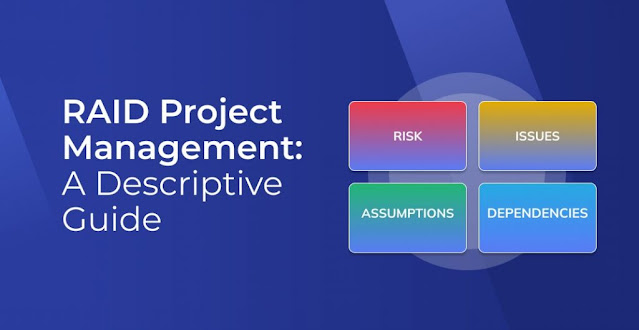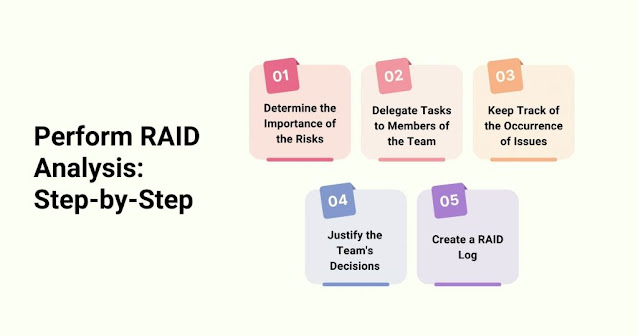For project managers, recognizing and mitigating risks before embarking on a new project is crucial. A RAID analysis can aid in task allocation and justify decisions made during the project’s lifecycle. Understanding the importance of a RAID log enables you to lead organized assignments in the workplace and assess the effectiveness of your endeavors. This article delves into RAID project management and its importance, outlining its advantages, and guides you through conducting RAID analysis for your upcoming project.
What is RAID Project Management?
RAID Project Management is a structured approach project managers use to identify, assess, and manage key factors that can impact the successful completion of a project. The acronym RAID stands for Risks, Assumptions, Issues, and Dependencies, representing the four categories of factors that are crucial for project managers to monitor and address.
1. Risks: Risks are potential events or situations that could have a negative impact on the project. These could include budget overruns, delays, technical challenges, or changes in market conditions. Identifying and mitigating risks early in the project can prevent major issues later.
2. Assumptions: Assumptions are factors that are considered to be true, real, or certain without any proof or demonstration. Project managers often make assumptions about resources, technologies, or stakeholder behavior. It’s important to recognize these assumptions and validate them to ensure they don’t become sources of problems later in the project.
3. Issues: Issues are problems or challenges that have already occurred and are affecting the project’s progress. These could include conflicts among team members, technical glitches, or delays in the supply chain. Effectively managing issues involves timely resolution and mitigation strategies to minimize their impact on the project timeline and objectives.
4. Dependencies: Dependencies refer to the relationships between tasks or activities within a project. Some tasks can only start or finish when others are completed. Understanding these dependencies is crucial for proper project scheduling and resource allocation. Managing dependencies ensures that tasks are sequenced correctly, preventing bottlenecks and ensuring smooth workflow.
By systematically analyzing and managing these factors, RAID Project Management provides a comprehensive view of potential challenges, enabling project managers to address them proactively. This approach enhances project transparency, reduces uncertainties, and ultimately increases the likelihood of project success.
Why is RAID Analysis is Important in Project Management?
RAID analysis is a critical tool in project management, serving as a structured approach to identify and manage Risks, Assumptions, Issues, and Dependencies within a project.
Here’s why RAID analysis holds paramount importance in project management:
Risk Mitigation
One of the primary functions of RAID analysis is to identify and assess potential risks in a project. By proactively identifying risks, project managers can develop strategies to mitigate or eliminate them, reducing the likelihood of these risks negatively impacting the project’s success. This risk mitigation approach is critical for avoiding cost overruns, delays, and quality issues.
Assumption Validation
Assumptions are inherent in project planning but can introduce significant uncertainties if validated. RAID analysis encourages project managers to scrutinize and validate assumptions, ensuring they are well-founded. This minimizes the chances of making decisions based on false assumptions, which can lead to project deviations.
Dependency Understanding
Dependencies among project tasks are often complex, and misunderstandings can lead to bottlenecks or inefficiencies. RAID analysis helps project managers understand these dependencies, ensuring that tasks are properly sequenced and resources are allocated efficiently. This leads to smoother project execution.
Improves Communication
RAID analysis enhances communication between the project team and stakeholders. It provides a structured framework for discussing and addressing risks, assumptions, issues, and dependencies. This transparency fosters a shared understanding of potential challenges and solutions, aligning everyone involved with the project’s objectives.
Project Control
Project managers maintain high control over the project’s trajectory by monitoring and managing the elements within a RAID analysis. They can make informed decisions, adapt to changes, and ensure that the project stays on track, meeting its goals and deadlines.
How to Perform RAID Analysis?
Performing a RAID analysis involves a systematic process to identify and manage Risks, Assumptions, Issues, and Dependencies in a project. Here’s a step-by-step guide on how to perform a RAID analysis in project management:
Determine the Importance of the Risks
In a RAID analysis, not all risks are equal. Some might have a minor impact on the project, while others could be catastrophic. It’s crucial to assess and rank risks based on their potential impact on the project’s objectives and their likelihood of occurring. This step involves a careful evaluation of each identified risk to prioritize them.
High-impact, high-likelihood risks should be prioritized as they pose the most significant threat to the project. Project managers can allocate resources and attention to the most critical areas by determining the importance of risks, ensuring a focused and effective risk management strategy.
Delegate Tasks to Members of the Team
Once risks, assumptions, issues, and dependencies are identified and analyzed, tasks related to mitigating or managing these elements must be assigned. Project managers should delegate specific tasks to team members based on their expertise and skills.
Delegation should be clear and specific, outlining the responsibilities of each team member in addressing the identified items.
Delegating tasks ensures a structured approach to managing RAID elements and that responsible individuals are accountable for their resolution.
Keep Track of the Occurrence of Issues
Issues are inevitable in any project. It’s essential to closely monitor the identified issues and monitor their progress toward resolution. Regular updates on the status of issues, including any changes or developments, should be tracked.
This ongoing monitoring ensures that issues are managed actively and that the project team takes appropriate actions to resolve them. It also enables quick responses to emerging challenges, preventing them from escalating into larger problems.
Justify the Team’s Decisions
During RAID analysis, the project team might need to make decisions related to risk mitigation strategies, assumption validation methods, issue resolution approaches, and dependency management techniques. These decisions should be well-justified, based on thorough analysis and relevant data.
Project managers should document and communicate the rationale behind each decision clearly within the team. Justifying decisions fosters understanding and consensus among team members, ensuring everyone is on the same page regarding the chosen course of action.
Create a RAID Log
A RAID log is a structured document that compiles all the information related to Risks, Assumptions, Issues, and Dependencies. It includes detailed descriptions of each item, their impact assessments, the assigned tasks and responsible team members, deadlines, and the status of resolution efforts.
Creating a RAID log serves as a central repository of critical project information. It provides a clear overview of the project’s potential challenges and its actions to address them. A well-maintained RAID log enhances transparency, accountability, and communication among the project team members and with stakeholders.
How to Create a RAID Document?
Creating a RAID document involves systematically organizing information related to Risks, Assumptions, Issues, and Dependencies in a clear and accessible format. Here’s a step-by-step guide on how to create a RAID document:
Schedule an Audit Meeting
Begin the process by scheduling a meeting with key project stakeholders and team members. This meeting serves as a platform to discuss and collaboratively identify potential Risks, Assumptions, Issues, and Dependencies (RAID). It encourages open communication and allows for diverse perspectives, ensuring a comprehensive assessment of the project’s landscape.
Determine RAID
During the audit meeting, engage in discussions to identify and define Risks, Assumptions, Issues, and Dependencies pertinent to the project. Risks could involve financial uncertainties or technological challenges, while Assumptions might relate to stakeholder behavior or resource availability.
Issues could include ongoing problems, and Dependencies might involve task sequences and interconnections within the project.
Generate a RAID Log
Based on the discussions and identified RAID elements, create a RAID log. This log should be organized, listing each item under its respective category (Risks, Assumptions, Issues, and Dependencies).
Include detailed descriptions, potential impact, priority levels, risk mitigation strategies, validation methods for assumptions, resolution plans for issues, and dependency management approaches. Structuring this information systematically makes it accessible and understandable for all stakeholders.
Share the Information
Distribute the RAID log among the project team members and relevant stakeholders. Transparent communication is vital. Ensure that everyone involved in the project understands the identified RAID elements, their implications, and the strategies devised to address them. Clarity and shared awareness empower the team to work cohesively toward resolving challenges and mitigating risks.
Check the RAID Log for Updates
Regularly update the RAID log to reflect changes in the project environment. New Risks might emerge, Assumptions could be validated or invalidated, Issues may arise or be resolved, and Dependencies might evolve. Schedule periodic reviews and encourage team members to report any new developments promptly. Keeping the RAID log current ensures the project team is equipped with the latest information, enabling agile decision-making and proactive management of project complexities.
Source: invensislearning.com







0 comments:
Post a Comment